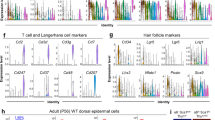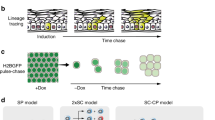Abstract
Tracking the fate of cells in murine epidermis in vivo has revealed that a committed progenitor cell population can maintain normal adult tissue in the long term without support from a long-lived, self-renewing population of stem cells. Here, we argue that these results challenge the dogma that stem-cell proliferation is required for the cellular homeostasis of the epidermis and other adult tissues, with important implications for tissue physiology and disease.
This is a preview of subscription content, access via your institution
Access options
Subscribe to this journal
Receive 12 print issues and online access
$189.00 per year
only $15.75 per issue
Buy this article
- Purchase on Springer Link
- Instant access to full article PDF
Prices may be subject to local taxes which are calculated during checkout



Similar content being viewed by others
References
Lajtha, L. G. Stem cell concepts. Differentiation 14, 23–34 (1979).
Brash, D. E., Zhang, W., Grossman, D. & Takeuchi, S. Colonization of adjacent stem cell compartments by mutant keratinocytes. Semin. Cancer Biol. 15, 97–102 (2005).
Fuchs, E. Scratching the surface of skin development. Nature 445, 834–842 (2007).
Potten, C. S. & Booth, C. Keratinocyte stem cells: a commentary. J. Invest. Dermatol. 119, 888–899 (2002).
Cotsarelis, G., Sun, T. T. & Lavker, R. M. Label-retaining cells reside in the bulge area of pilosebaceous unit: implications for follicular stem cells, hair cycle, and skin carcinogenesis. Cell 61, 1329–1337 (1990).
Oshima, H., Rochat, A., Kedzia, C., Kobayashi, K. & Barrandon, Y. Morphogenesis and renewal of hair follicles from adult multipotent stem cells. Cell 104, 233–245 (2001).
Tumbar, T. et al. Defining the epithelial stem cell niche in skin. Science 303, 359–363 (2004).
Morris, R. J. et al. Capturing and profiling adult hair follicle stem cells. Nature Biotechnol. 22, 411–417 (2004).
Ghazizadeh, S. & Taichman, L. B. Multiple classes of stem cells in cutaneous epithelium: a lineage analysis of adult mouse skin. EMBO J. 20, 1215–1222 (2001).
Claudinot, S., Nicolas, M., Oshima, H., Rochat, A. & Barrandon, Y. Long-term renewal of hair follicles from clonogenic multipotent stem cells. Proc. Natl Acad. Sci. USA 102, 14677–14682 (2005).
Levy, V., Lindon, C., Harfe, B. D. & Morgan, B. A. Distinct stem cell populations regenerate the follicle and interfollicular epidermis. Dev. Cell 9, 855–861 (2005).
Ito, M. et al. Stem cells in the hair follicle bulge contribute to wound repair but not to homeostasis of the epidermis. Nature Med. 11, 1351–1354 (2005).
Potten, C. S. The epidermal proliferative unit: the possible role of the central basal cell. Cell Tissue Kinet. 7, 77–88 (1974).
Potten, C. S. Epidermal cell production rates. J. Invest. Dermatol. 65, 488–500 (1975).
Kaur, P. Interfollicular epidermal stem cells: identification, challenges, potential. J. Invest. Dermatol. 126, 1450–1458 (2006).
Mackenzie, I. C. Relationship between mitosis and the ordered structure of the stratum corneum in mouse epidermis. Nature 226, 653–655 (1970).
Morris, R. J., Fischer, S. M. & Slaga, T. J. Evidence that the centrally and peripherally located cells in the murine epidermal proliferative unit are two distinct cell populations. J. Invest. Dermatol. 84, 277–281 (1985).
Braun, K. M. et al. Manipulation of stem cell proliferation and lineage commitment: visualisation of label-retaining cells in wholemounts of mouse epidermis. Development 130, 5241–5255 (2003).
Mackenzie, I. C. Labelling of murine epidermal Langerhans cells with H3-thymidine. Am. J. Anat. 144, 127–136 (1975).
Valladeau, J. & Saeland, S. Cutaneous dendritic cells. Semin. Immunol. 17, 273–283 (2005).
Ghaznawie, M., Papadimitriou, J. M. & Heenan, P. J. The steady-state turnover of murine epidermal Langerhans cells. Br. J. Dermatol. 141, 57–61 (1999).
Merad, M. et al. Langerhans cells renew in the skin throughout life under steady-state conditions. Nature Immunol. 3, 1135–1141 (2002).
Mackenzie, I. C. & Bickenbach, J. R. Label-retaining keratinocytes and Langerhans cells in mouse epithelia. Cell Tissue Res. 242, 551–556 (1985).
Schmidt, G. H., Blount, M. A. & Ponder, B. A. Immunochemical demonstration of the clonal organization of chimaeric mouse epidermis. Development 100, 535–541 (1987).
Mackenzie, I. C. Retroviral transduction of murine epidermal stem cells demonstrates clonal units of epidermal structure. J. Invest. Dermatol. 109, 377–383 (1997).
Kameda, T. et al. Analysis of the cellular heterogeneity in the basal layer of mouse ear epidermis: an approach from partial decomposition in vitro and retroviral cell marking in vivo . Exp. Cell Res. 283, 167–183 (2003).
Ro, S. & Rannala, B. A stop-EGFP transgenic mouse to detect clonal cell lineages generated by mutation. EMBO Rep. 5, 914–920 (2004).
Ro, S. & Rannala, B. Evidence from the stop-EGFP mouse supports a niche-sharing model of epidermal proliferative units. Exp. Dermatol. 14, 838–843 (2005).
Barrandon, Y. & Green, H. Three clonal types of keratinocyte with different capacities for multiplication. Proc. Natl Acad. Sci. USA 84, 2302–2306 (1987).
Jones, P. H., Harper, S. & Watt, F. M. Stem cell patterning and fate in human epidermis. Cell 80, 83–93 (1995).
Li, A., Pouliot, N., Redvers, R. & Kaur, P. Extensive tissue-regenerative capacity of neonatal human keratinocyte stem cells and their progeny. J. Clin. Invest. 113, 390–400 (2004).
Wan, H. et al. Desmosomal proteins, including desmoglein 3, serve as novel negative markers for epidermal stem cell-containing population of keratinocytes. J. Cell Sci. 116, 4239–4248 (2003).
Lowell, S., Jones, P., Le Roux., I., Dunne, J. & Watt, F. M. Stimulation of human epidermal differentiation by Delta-Notch signalling at the boundaries of stem-cell clusters. Curr. Biol. 10, 491–500 (2000).
Legg, J., Jensen, U. B., Broad, S., Leigh, I. & Watt, F. M. Role of melanoma chondroitin sulphate proteoglycan in patterning stem cells in human interfollicular epidermis. Development 130, 6049–6063 (2003).
Jensen, K. B. & Watt, F. M. Single-cell expression profiling of human epidermal stem and transit-amplifying cells: Lrig1 is a regulator of stem cell quiescence. Proc. Natl Acad. Sci. USA 103, 11958–11963 (2006).
Li, A., Simmons, P. J. & Kaur, P. Identification and isolation of candidate human keratinocyte stem cells based on cell surface phenotype. Proc. Natl Acad. Sci. USA 95, 3902–3907 (1998).
Jensen, U. B., Lowell, S. & Watt, F. M. The spatial relationship between stem cells and their progeny in the basal layer of human epidermis: a new view based on whole-mount labelling and lineage analysis. Development 126, 2409–2418 (1999).
Ghazizadeh, S. & Taichman, L. B. Organization of stem cells and their progeny in human epidermis. J. Invest. Dermatol. 124, 367–372 (2005).
Clayton, E. et al. A single type of progenitor cell maintains normal epidermis. Nature 446, 185–189 (2007).
Galton, F. & Watson, F. H. On the probability of the extinction of families. J. R. Anthropol. Inst., 138–144 (1874).
Bienaymé, I. J. De la loi de multiplication et de la duree des familles. Soc. Philomath. Paris Extraits Ser. 5, 37–39 (1845).
Bickenbach, J. R. Identification and behavior of label-retaining cells in oral mucosa and skin. J. Dent. Res. 60, 1611–1620 (1981).
Lechler, T. & Fuchs, E. Asymmetric cell divisions promote stratification and differentiation of mammalian skin. Nature 437, 275–280 (2005).
Potten, C. S. et al. Proliferation in murine epidermis after minor mechanical stimulation. Part 1. Sustained increase in keratinocyte production and migration. Cell Prolif. 33, 231–246 (2000).
Taylor, G., Lehrer, M. S., Jensen, P. J., Sun, T. T. & Lavker, R. M. Involvement of follicular stem cells in forming not only the follicle but also the epidermis. Cell 102, 451–461 (2000).
Levy, V., Lindon, C., Zheng, Y., Harfe, B. D. & Morgan, B. A. Epidermal stem cells arise from the hair follicle after wounding. FASEB J. 21, 1358–1366 (2007).
Owens, D. M. & Watt, F. M. Contribution of stem cells and differentiated cells to epidermal tumours. Nature Rev. Cancer 3, 444–451 (2003).
Zhang, W., Remenyik, E., Zelterman, D., Brash, D. E. & Wikonkal, N. M. Escaping the stem cell compartment: sustained UVB exposure allows p53-mutant keratinocytes to colonize adjacent epidermal proliferating units without incurring additional mutations. Proc. Natl Acad. Sci. USA 98, 13948–13953 (2001).
Dor, Y., Brown, J., Martinez, O. I. & Melton, D. A. Adult pancreatic β-cells are formed by self-duplication rather than stem-cell differentiation. Nature 429, 41–46 (2004).
Bickenbach, J. R. & Chism, E. Selection and extended growth of murine epidermal stem cells in culture. Exp. Cell Res. 244, 184–195 (1998).
Mackenzie, I. C., Zimmerman, K. & Peterson, L. The pattern of cellular organization of human epidermis. J. Invest. Dermatol. 76, 459–461 (1981).
Potten, C. S. Psoriasis: Cell Proliferation (eds Wright, N. A. & Camplejohn, R. S.) (Churchill Livingstone, Edinburgh, 1983).
Klein, A. M., Doupe, D. P., Jones, P. H. & Simons, B. D. Kinetics of cell division in epidermal maintenance. Phys. Rev. E 76, 021910 (2007).
Acknowledgements
We acknowledge the important contributions made by E. Clayton, D. Doupé, A. Klein and D. Winton in formulating the new insights reflected in this work, and we are grateful to W. Harris and A. Philpott for discussions.
Author information
Authors and Affiliations
Corresponding author
Related links
Rights and permissions
About this article
Cite this article
Jones, P., Simons, B. OPINION Epidermal homeostasis: do committed progenitors work while stem cells sleep?. Nat Rev Mol Cell Biol 9, 82–88 (2008). https://doi.org/10.1038/nrm2292x
Issue Date:
DOI: https://doi.org/10.1038/nrm2292x



